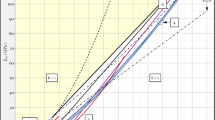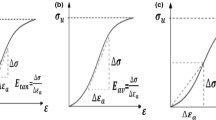Abstract
Young’s modulus is one of the most important mechanical parameters in building materials used to assess both the appropriateness of a material as well as its mechanical stability. The paper reports a study to predict the elastic modulus for ten carbonate rocks using the ultrasonic technique. The rocks varied from homogeneous limestones to rocks with abundant stylolite, veins and fissures and were subjected to both salt crystallization and thermal weathering tests in order to modify the number and features of their discontinuities. The dynamic and static elastic moduli were measured in both weathered and unweathered samples. The results confirmed the poor relationship between the static and dynamic moduli for the studied rocks. A new equation is proposed which uses both dynamic elastic modulus and spatial attenuation of compressive waves to provide an accurate prediction of static Young’s modulus. As spatial attenuation is highly sensitive to the presence of rock defects, the correlation is very useful for rocks with fractures, voids and/or which have suffered weathering.
Résumé
Le module d’Young est l’un des plus importants paramètres mécaniques des matériaux de construction. Il est utilisé pour évaluer à la fois l’adéquation d’un matériau et sa stabilité mécanique. L’article présente une étude visant à prévoir le module d’élasticité de dix roches carbonatées à partir de la technique des ultrasons. Les roches testées allaient des calcaires homogènes aux calcaires avec de nombreux stylolites, veinules et fissures. Elles furent soumises à des tests de cristallisation de sels et d’altération thermique afin de modifier le nombre et les caractéristiques de leurs défauts. Les modules statiques et dynamiques furent mesurés à la fois pour les échantillons sains et pour les échantillons altérés. Les résultats ont confirmé les relations faibles entre module statique et module dynamique pour les roches étudiées. Une nouvelle équation est proposée qui, à partir du module d’élasticité dynamique et de l’atténuation spatiale des ondes de compression, fournit une prévision du module d’Young statique. Du fait que l’atténuation spatiale des ondes de compression est hautement sensible à la présence de défauts dans les roches, la corrélation établie est très utile pour les roches contenant des fissures et des vides ou qui ont été soumises à de l’altération.




Similar content being viewed by others
References
Al-Shayea NA (2004) Effects of testing methods and conditions on the elastic properties of limestone rock. Eng Geo 74:139–156
ASTM D 3148–96 (1996) Standard test for elastic moduli of intact rock core specimens in uniaxial compression, p 21
Christaras B, Auger F, Mosse E (1994) Determination of the moduli of elasticity of rocks. Comparison of the ultrasonic velocity and mechanical resonance frequency methods with direct static methods. Mater Struct 27:222–228
Ciccotti M, Mulargia F (2004) Differences beween static and dynamic elastic moduli of a typical seismogenic rock. Geophys J Int 157:474–477
Guéguen Y, Palciauskas V (1994) Introduction to the physics of rocks. Princeton University Press, New Jersey, p 294
Martínez-Martínez J (2009) Influencia de la alteración sobre las propiedades mecánicas de calizas, dolomías y mármoles. Evaluación mediante estimadores no destructivos (ultrasonidos) (In Spanish). Universidad de Alicante, p 278
Martínez-Martínez J, Benavente D, García-del-Cura MA (2011) Spatial attenuation: the most sensitive ultrasonic parameter for detecting petrographic features and decay processes in carbonate rocks. Eng Geo 119(3–4):84–95
Rodríguez Sastre MA, Calleja L (2004) Caracterización del comportamiento elástico de materiales pizarrosos del Sinclinal de Truchas mediante ultrasonidos (In Spanish). Trabajos de Geología, Universidad de Oviedo 24:153–164
Saenger EH, Krüger OS, Shapiro SA (2006) Effective elastic properties of fractured rocks: dynamic vs. static considerations. Int J Fracture 139:569–576
Schön JH (1996) Physical properties of rocks: fundamentals and principles of petrophysics. In: Helbig K, Treitel S (eds) Handbook of geophysical exploration, section I, seismic exploration, vol 18. Oxford, Pergamon, p 583
Song I, Suh M, Woo YK, Hao T (2004) Determination of the elastic modulus set of foliated rocks from ultrasonic velocity measurements. Eng Geo 72:293–308
UNE-EN 1926 (1999) Métodos de ensayo para piedra natural. Determinación de la resistencia a la compresión (In Spanish). AENOR. pp 17
Acknowledgments
This study was financed by the Spanish Ministry of Education and Science (MEC): project CGL2006-05027/BTE. A pre-doctoral research fellowship was awarded to J. Martínez-Martínez by the Higher Council of Scientific Investigations (CSIC, Spain).
Author information
Authors and Affiliations
Corresponding author
Rights and permissions
About this article
Cite this article
Martínez-Martínez, J., Benavente, D. & García-del-Cura, M.A. Comparison of the static and dynamic elastic modulus in carbonate rocks. Bull Eng Geol Environ 71, 263–268 (2012). https://doi.org/10.1007/s10064-011-0399-y
Received:
Accepted:
Published:
Issue Date:
DOI: https://doi.org/10.1007/s10064-011-0399-y




